Most homes are heated and cooled through a central, whole-home, Heating, Ventilating, and Air-Conditioning system (HVAC). The HVAC may well be one of the most expensive and energy hungry systems in the home, so the more you know about your HVAC, the better. A well-informed homeowner will save money and have a healthier, more comfortable home.
HVAC System Components
Central HVAC systems are often called “split” systems because some of the components are installed inside the home and some of the components are installed outside a home. Inside your home, usually installed in the basement, attic, or a closet, you’ll find the furnace (oil, gas, or electric) and the evaporator portion of the air-conditioner. You’ll also find the blower (sometimes called an air handler), which serves both the furnace and the air-conditioner. Attached to the blower are ducts, which are tubes acting as pathways to deliver heated or cooled air to various rooms in the house.

If your HVAC system is a heat pump, it won’t have a separate furnace. Dave Moody, an HVAC industry pro with Service Experts, explains, “A heat pump works like a regular air-conditioner in the summer, then essentially works in reverse in the winter, serving both cooling and heating purposes.” A heat-pump system will still have indoor and outdoor components.
Outside the house you’ll find the compressor and condenser components of the central air-conditioner (or heat pump), which are mounted in a metal cabinet with a large fan.
One alternative to a split-system is called a “packaged” system, in which all components are installed in a single unit outside the home, with ducts entering through the wall of the home. These units may be preferable for a homeowner who doesn’t want to waste space on the interior of their home with heating and cooling equipment.
Not often addressed in most HVAC installations is the “V” – ventilation. Most homes rely on infiltration, or air that seeps in through gaps and cracks in the home’s shell, for limited fresh air. Service Experts’ Moody says, “As indoor air quality (IAQ) is increasingly implicated as a big factor in human health problems, mechanical ventilation systems are becoming more commonplace.” More about that in the “ventilation” section below.
No comments:
Post a Comment